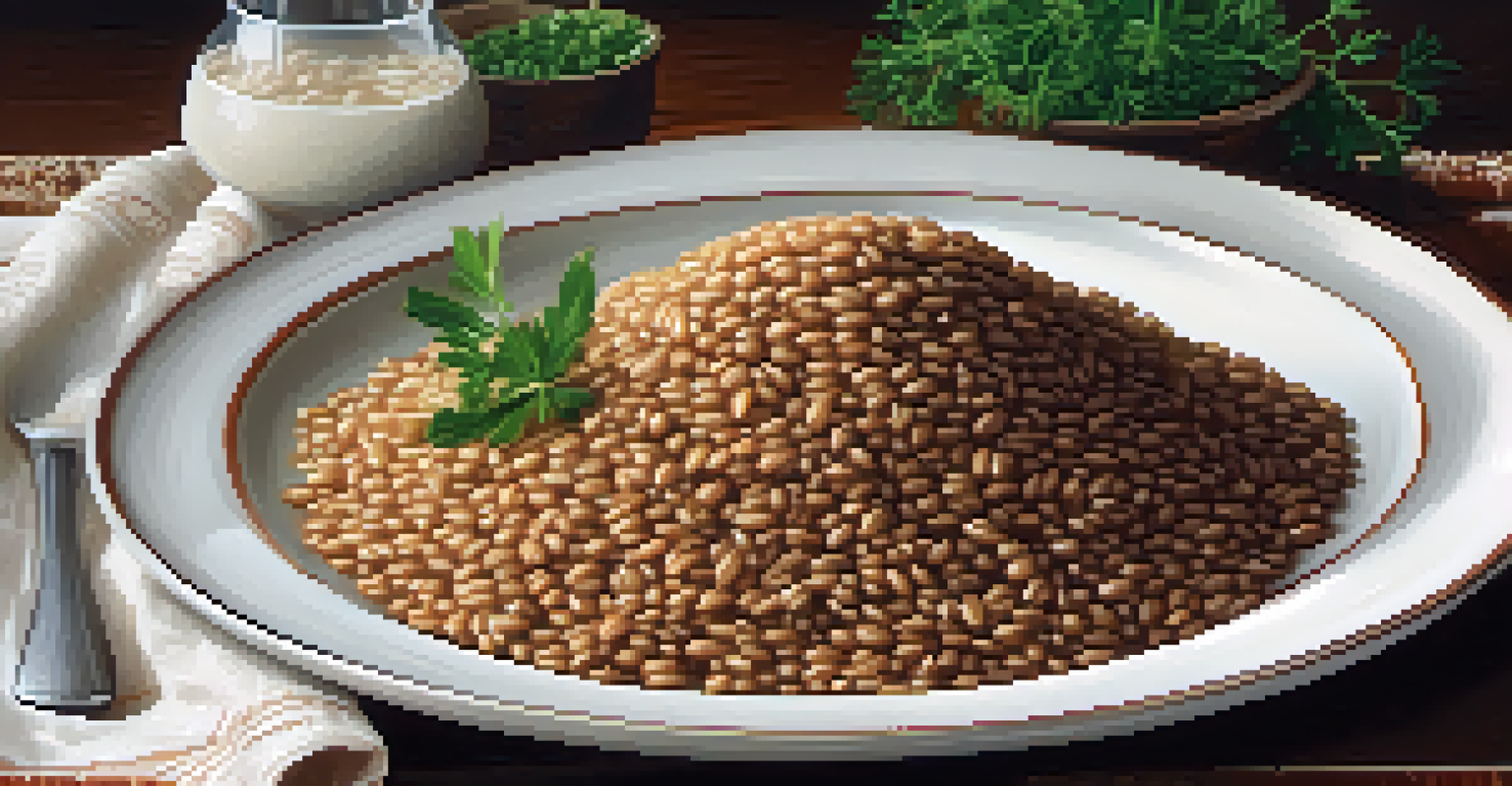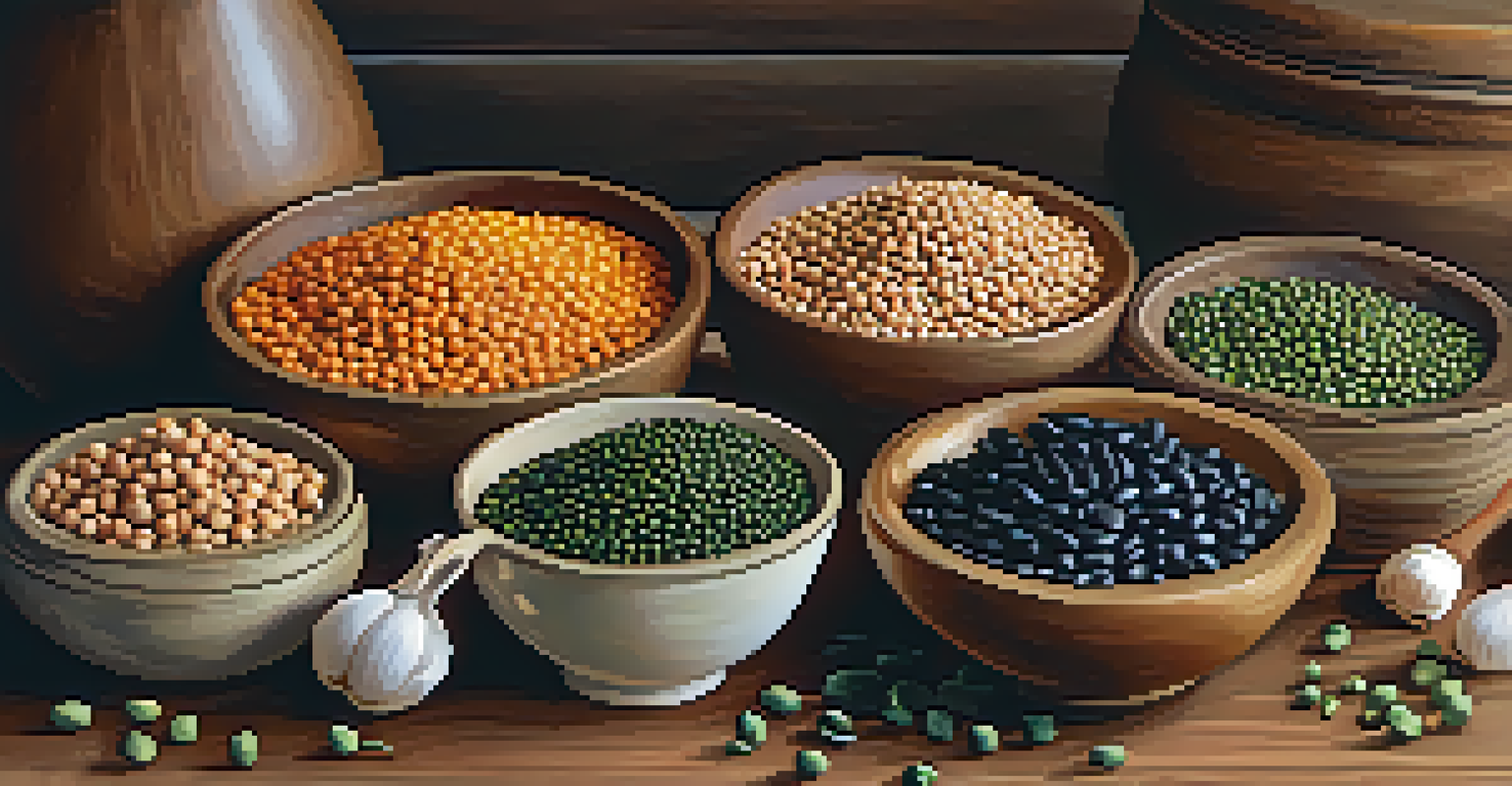Pairing Legumes and Grains for Complete Vegetarian Nutrition

Understanding the Importance of Complete Proteins
When it comes to vegetarian nutrition, one key concept is complete proteins. These are proteins that contain all nine essential amino acids our bodies can’t produce on their own. While animal products offer these amino acids, plant-based foods often fall short. However, by combining legumes and grains, vegetarians can create a complete protein profile, ensuring they get all the nutrients needed for optimal health.
Let food be thy medicine and medicine be thy food.
For example, beans are high in lysine but low in methionine, while grains like rice have the opposite profile. When enjoyed together, they complement each other perfectly. This means that a bowl of rice and beans not only fills you up but also fuels your body with the necessary building blocks for muscle and tissue repair.
Understanding complete proteins is vital for vegetarians. It encourages thoughtful meal planning and inspires creativity in the kitchen, making the journey toward a balanced diet both enjoyable and rewarding.
Exploring Different Types of Legumes
Legumes are a diverse group of plants that include beans, lentils, peas, and chickpeas. Each type brings its own unique flavor and nutritional benefits to the table. For instance, lentils cook quickly and are packed with protein and fiber, making them an excellent choice for soups and salads. Meanwhile, black beans are not only rich in protein but also contain vital antioxidants.

One of the beauties of legumes is their versatility. They can be mashed into spreads, tossed into stir-fries, or even blended into smoothies for a protein boost. This adaptability means that there are endless possibilities for incorporating them into meals while keeping your diet exciting.
Complete Proteins for Vegetarians
Combining legumes and grains ensures vegetarians receive all essential amino acids for optimal health.
Moreover, legumes are often budget-friendly and have a long shelf life, making them a staple in many households. Whether you prefer them dried, canned, or frozen, they can easily fit into your weekly grocery list.
Different Grains: Nutritional Powerhouses
Grains are another essential component of a balanced vegetarian diet. They provide carbohydrates for energy and are often rich in vitamins and minerals. Whole grains, such as quinoa, brown rice, and barley, offer more nutrients than their refined counterparts, including fiber that aids digestion and helps keep you full.
The food you eat can either be the safest and most powerful form of medicine or the slowest form of poison.
Quinoa stands out from other grains because it, too, is a complete protein. This means that when paired with legumes, like black beans, you have a powerhouse meal filled with nutrients. Additionally, grains can be used in a variety of dishes—from breakfast porridge to dinner pilafs—making them a versatile option.
Incorporating a range of grains into your meals can also keep your diet interesting. Experimenting with different grains can add unique textures and flavors to your dishes, enhancing your overall eating experience.
The Art of Pairing Legumes and Grains
Pairing legumes and grains isn't just about nutrition; it's also an art form. The goal is to achieve a balance in flavors and textures while maximizing health benefits. For instance, a classic combination is lentils and rice, where the earthy taste of lentils complements the mild flavor of rice beautifully.
Another excellent pairing is chickpeas with quinoa. The nutty flavor of quinoa enhances the creamy texture of chickpeas, creating a dish that’s not only tasty but also packed with protein. You can create delicious salads, wraps, or grain bowls that showcase these pairings.
Versatile Legumes and Grains
Legumes and grains can be easily incorporated into various meals, offering diverse flavors and nutritional benefits.
Experimenting with different herbs, spices, and cooking methods can elevate your meals. Don’t hesitate to try out new combinations until you find your favorites—your taste buds will thank you!
Delicious Recipes to Try at Home
To get started with pairing legumes and grains, why not try a simple recipe? A black bean and quinoa salad can be a refreshing dish packed with nutrients. Combine cooked quinoa with black beans, diced tomatoes, corn, and a squeeze of lime for a zesty flavor.
Another delightful option is a lentil and brown rice casserole. Mix cooked lentils and rice, add some sautéed vegetables, and top with cheese or a vegan alternative before baking. It’s a comforting meal that the whole family will love.
These recipes not only highlight the deliciousness of legumes and grains but also demonstrate how easy it is to create balanced vegetarian meals at home. With just a little creativity, you can whip up dishes that are both nutritious and satisfying.
Nutrient Benefits of Combining Legumes and Grains
Combining legumes and grains is not just about protein; it also enhances the overall nutrient profile of your meals. This pairing provides a wealth of vitamins, minerals, and antioxidants that contribute to better health. For example, beans are rich in iron and folate, while whole grains offer B vitamins and magnesium.
Additionally, this combination helps regulate blood sugar levels, thanks to the high fiber content. Fiber slows down the absorption of sugar into the bloodstream, preventing spikes and crashes that can lead to fatigue and cravings. Keeping your energy levels stable is crucial, especially for those with active lifestyles.
Health Benefits of Pairing Foods
Pairing legumes and grains boosts nutrient intake and helps regulate blood sugar levels, promoting overall well-being.
Ultimately, these nutrient benefits underscore the significance of mindful eating. By focusing on pairing legumes and grains, you’re not only nourishing your body but also fostering a holistic approach to health.
Tips for Incorporating More Legumes and Grains
Incorporating more legumes and grains into your diet can be easy and enjoyable. Start by adding a serving of beans or lentils to your salads, soups, or tacos. This small change can significantly boost the nutritional value of your meals without requiring drastic overhauls.
You can also try swapping out refined grains for whole grains in your daily meals. For example, choose whole grain bread or pasta instead of white varieties. This simple switch can provide more fiber and nutrients, making your meals more satisfying.

Lastly, don’t be afraid to explore new recipes and cuisines that highlight these ingredients. From Mediterranean hummus to Indian dal, the world of legumes and grains is vast and flavorful, offering endless possibilities for healthy eating.